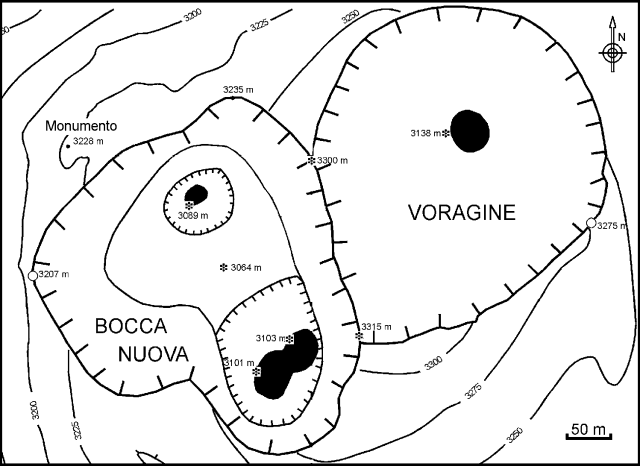Report on Etna (Italy) — May 1997
Bulletin of the Global Volcanism Network, vol. 22, no. 5 (May 1997)
Managing Editor: Richard Wunderman.
Etna (Italy) New map of the craters Voragine and Bocca Nuova
Please cite this report as:
Global Volcanism Program, 1997. Report on Etna (Italy) (Wunderman, R., ed.). Bulletin of the Global Volcanism Network, 22:5. Smithsonian Institution. https://doi.org/10.5479/si.GVP.BGVN199705-211060
Etna
Italy
37.748°N, 14.999°E; summit elev. 3357 m
All times are local (unless otherwise noted)
A map prepared from observations carried out on 11 April of Voragine and Bocca Nuova craters is presented in figure 66. The position and altitude of the points shown by stars were measured with ranging binoculars (model 1500 DAES; on loan courtesy Leica-France) from two observation points (circles) on the rim of the craters. Photos of the crater interior were also used to draw the map.
 |
Figure 66. Map of the Etna craters prepared using LEICA binoculars. Courtesy of P. Briole, O. Consoli, C. Deplus, and J-L. Froger, IPGP. |
Bocca Nuova crater measured ~170 m deep and had two active cones on the crater floor. The N cone, 25 m above the crater floor, was the most active. Its Strombolian activity threw ejecta close to Monumento, a spot on the crater's N rim. The S cone, 35-40 m above the crater floor, appeared composed of two coalescent cones, and was less active then the N one.
The depth of the Voragine crater measured ~150 m. Quiet steam emission was observed escaping from the large hole on the lower part of the crater floor.
Geological Summary. Mount Etna, towering above Catania on the island of Sicily, has one of the world's longest documented records of volcanism, dating back to 1500 BCE. Historical lava flows of basaltic composition cover much of the surface of this massive volcano, whose edifice is the highest and most voluminous in Italy. The Mongibello stratovolcano, truncated by several small calderas, was constructed during the late Pleistocene and Holocene over an older shield volcano. The most prominent morphological feature of Etna is the Valle del Bove, a 5 x 10 km caldera open to the east. Two styles of eruptive activity typically occur, sometimes simultaneously. Persistent explosive eruptions, sometimes with minor lava emissions, take place from one or more summit craters. Flank vents, typically with higher effusion rates, are less frequently active and originate from fissures that open progressively downward from near the summit (usually accompanied by Strombolian eruptions at the upper end). Cinder cones are commonly constructed over the vents of lower-flank lava flows. Lava flows extend to the foot of the volcano on all sides and have reached the sea over a broad area on the SE flank.
Information Contacts: Pierre Briole, Orazio Consoli, Christine Deplus, and Jean-Luc Froger, Institut de Physique du Globe de Paris, Case 89, 4 place Jussieu, 75252 Paris Cedex 05, France.

